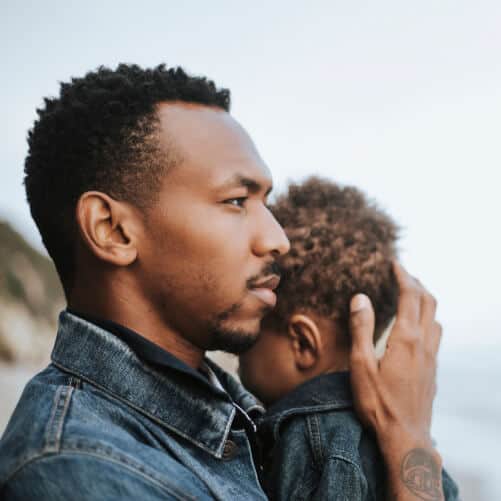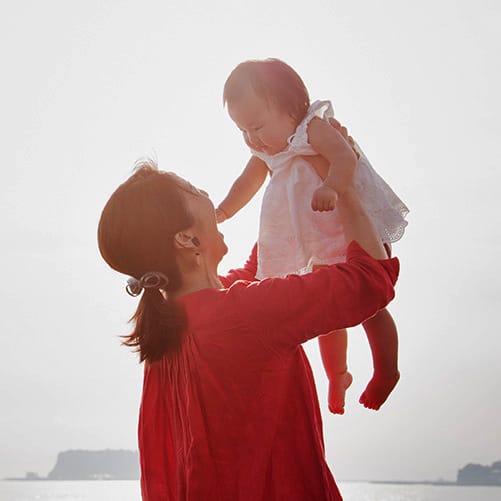6 August 2025
“Whether you reach agreement by mediation, therapy, or traditional English repression of past problems does not bother me… Make your relationships work so that he benefits.”
F v J & Others [2024[ EWHC 2802 (Fam) is a case which deals with the realities and challenges of co-parenting and highlights the complexities of known sperm donation – how it should be approached with great care and proactive management of the legal aspects which underpin these family building arrangements. Specifically, it raises issues of legal parentage in the context of known sperm donation and assisted reproduction, and what can happen when this process is rushed or hurried. Additionally, this case raises concerns around communication in co-parenting relationships, and stresses the importance of the stability of those relationships, both for the benefit of the parents, and for the wellbeing of the child.
Background
F and J were longstanding friends, they had met as teenagers and they had bonded over the fact that, around the time of their friendship, both of them were in the process of coming out as gay and lesbian respectively. By 2018, the pair were living in London, both having attended college there. At this point, J was in a relationship with T, and was seeking to start a family with her. To this effect, she approached F, and asked him to be their sperm donor. F refused, stating decidedly that he wanted to be the child’s parent and not just the donor.
In 2020, J re-approached F, asking him once more, with the added condition that he would be an active father in the child’s life. F accepted. The clinic consent forms signed at the time recorded J and T as the child’s legal parents, and F was only listed as a ‘known donor’. It was at this time agreed however, that F would play an involved role in the life of the child.
In 2021, after J had begun fertility treatments at King’s Fertility Clinic, J and T’s relationship deteriorated and, while the couple broke up, J continued with her fertility treatments. Due to this break-up, T was removed from the position of L’s legal second parent, and F expressed to J his desire to be recorded as the second parent in her place. J agreed to F being recorded as L’s legal father. However, she was then informed by the clinic that if F’s status was changed from that of the donor to that of the parent, then there must be a one year cooling off period before they could resume treatment. Having turned 40 that year, J was worried about the viability of conception as she was getting older, and so chose not to delay treatment, meaning that F could not be put down as L’s father and J was recorded as the sole parent.
In 2022, J began a relationship with B, and they moved in together in January 2023. During this relationship, J’s attempts to conceive continued and there were some discussions between F, J and B about co-parenting any child born. In March 2023, a successful embryo transfer took place and L was conceived. At this point, after conception, the three parties (F, J and B) discussed drawing up a legal agreement governing parenting arrangements. They then realised that they had different views and expectations and so attended mediation and counselling to reach an agreement.
Mr Justice Trowell acknowledged an email written by B at this time which records that F, J and B will “share the care of the child, but that “the care will need to be fluid, may not be equal but they will endeavour to make it balanced”. However, these notes were not agreed by F or J and so they did not constitute a confirmed agreement.
In April 2023, F, J and B decided to rent a property together, with the aim of facilitating their co-parenting arrangement. This agreement broke down however, due to disagreements about how the co-parenting would take place. F felt outnumbered by J and B, resenting the latter for expecting to be treated as an equal to himself and J when, (a) she had no biological connection to the child and (b), she had arrived late to the arrangement, as fertility treatment had begun before her relationship with J had.
J knew full well that F wanted to be more than a donor, he wanted to be the child’s father. Mr Justice Trowell went on to say that J “…felt overwhelmed, I find, by the conflicted situation in which she now found herself recognising on the one hand that F thought he was entering into an agreement to be an active father but on the other hand needing to resit the arguments by which he tried to assert himself, push for more than she was prepared to yield, and diminish B’s role”.
In October 2023, F instructed solicitors to draft a legal parenting agreement which spelt out that decisions regarding L’s welfare were to be made by F and J alone, not by B. This was unacceptable to J and B.
In that same month, J and B were married and F attended the ceremony. A month later, in November 2023, J and B asked F to move out of their shared flat, which he did so on 13 of that month.
L was born on 10 of November 2023.
On 10 January 2024, despite there having been some contact, albeit an uncomfortable situation, F was informed by J and B’s solicitor that the contact between F and L was to be paused. Furthermore, the letter advised F that B had now obtained parental responsibility by way of a court ratified Step-Parental Agreement.
By the end of January 2024, in response to J and B’s solicitor letter, F had issued both an application for a Declaration of Parentage and an application for a Child Arrangements Order.
A Declaration of Parentage, pursuant to section 55A of the Family Law Act 1986, is a way for a parent to obtain legal confirmation of their parentage, and can lead to a change or re-registration of the child’s birth certificate. However, F’s Declaration of Parentage application was subsequently withdrawn.
When making a Child Arrangements Order the Judge has two choices. The first is a ‘lives with’ order, and the second is a ‘spends time with’ order. A ‘lives with’ order is an order which details where the child should live, often meaning that the child must live with both of their parents. A ‘spends time with’ order details how the child must spend time with a non-resident parent, and is used to ensure that the child is not alienated from one of their parents.
F had twice previously attempted to apply for a ‘lives with order’, but was refused, probably because he was recorded as a ‘known donor’, not as father on the clinic consent forms. Due to this, the Judge denied considering a ‘lives with’ Child Arrangements Order because F had been refused such an order twice in the past, and so was only considering a ‘spends time with’ order, which would allow F contact with L, but did not allow F to live with L.



Images: Royal Courts of Justice, Strand, London
Court Proceedings and the Evidence
Initially, F wanted parental responsibility and 4 days and nights of contact each fortnight – alternate Wednesdays and alternate weekends for three days. Parental responsibility dictates the power and authority that a person can be granted to make welfare decisions to secure the best interests and upbringing of a child. It is not a biological term, and a person can be granted parental responsibility even if they are not the child’s legal or biological parent.
Over the four days in which the hearing took place, Mr Justice Trowell heard evidence from F, J, B and Allison Baker, the Child’s CAFCASS (Children and Family Court Advisory Service) Guardian, as well as a Consultant Clinical Psychologist – Dr Pettle.
All the respondents [i.e. J, B and Mrs Baker] said no to F being granted parental responsibility, and it was Ms Baker’s initial view that opposed the 4 days of contact a fortnight suggested by F and stated instead there should be one visit every two months. This limitation of F’s contact with L was proposed by the respondents on the basis that J could not cope with it and that the contact between L and F would be damaging due to J’s fear that F would “take L from her’”. The Guardian, Ms Baker, agreed that J would struggle to cope with F being allowed frequent contact.
Dr Pettle, the consultant clinical psychologist, gave evidence to the opposite, to the fact that J and B’s marriage was sufficiently strong and supportive so as to allow for contact. She felt that prolonging the time between contact would prove to be damaging to L, who, being so young, was not being allowed sufficient time to bond with and remember F, and therefore, every meeting would merely be a reintroduction “again and again”. Dr Pettle gave further evidence that “what the three adults need to do is mend their relationship” and that “this was a tragic case: three adults, all with much to offer L, but who had fallen out rather than worked together” and she “urged therapeutic input as the way of moving things forward”.
Instead of the proposed meeting of once every 8 weeks, Dr Pettle compromised, suggesting contact every four weeks starting with an hour initially, increasing to two hours and then half a day by the time L was 3 to 3 and ½ years old. In doing so, she acknowledged that J would likely have trouble adjusting in the short term, and that this would be a risk, but she ultimately felt that J was strong enough and would cope.
F then gave evidence. Mr Justice Trowell found “It was difficult not to be sympathetic to his position. It was clear that he believed that he had an agreement with a long-term friend that he was going to become a father, with all that entails. This would have been a fulfilment of a lifelong hope. He was upset and angry that hope was now bring dashed”. The Judge went on to acknowledge that whilst F had much to offer L he “did however also strike me as someone overly concerned about his rights, and the wrong that had been done to him, rather than how he was going to manage a relationship with J and B for the benefit of L”.
Ms Baker conceded that Dr Pettle was right, that L would not have the chance to remember and bond with F, but emphasised her worry about the risk posed by J’s inability to cope. She told the court to err on the side of caution and to proceed with the assumption that J’s fear was not only reasonable, but a genuine threat, rather than brush it off and have L suffer the consequences later down the line, whatever those consequences may be.
Judgment
After hearing all of the evidence over a four-day hearing, Mr Justice Trowell concluded that:
“It is appropriate for me to make an order in relation to ‘spends time with’ orders in accordance with Ms Baker’s final recommendation [alternate monthly contact for a year with monthly contact thereafter] …The critical consideration here is a balance between the benefit to L knowing and developing a relationship with his biological father and the risk to L of his care by J and B deteriorating because of the impact on them of the contact… I conclude on the side of caution- because I prefer the rock of caution to the sand of risk.”
Mr Justice Trowell did not grant F parental responsibility for L as this would risk destabilising J. Instead specific issue orders were made to keep F informed about what was happening to L, specifically any:
- settled intention to move L out of the jurisdiction.
- settled intention to cause L’s name to be changed.
- settled intention to cause L to be adopted.
- significant issue as to L’s health.
- legal proceedings involving L.
Above all else, Mr Justice Trowell chose the safety and security of the child, L, over whatever rights or expectations to which the parents felt themselves to be entitled. While being sympathetic and understanding of what F felt to be an unfair position, his hopes of fatherhood and parenthood dashed, Mr Justice Trowell agreed with the CAFCASS Guardian Ms Allison Baker that the most important aspect of the case was the welfare of L. It was L who was the most vulnerable party, not the adults, who, all expert witnesses and the Judge agreed, must get over fallings out for L’s sake, and must come together to move forward to allow L the benefits of the co-parenting arrangement.
Lessons to be learned
The case of F v J and Others highlights the issues and problems posed by known donation and co-parenting relationships where lack of communication, mismatched expectations and lack of legal advice at the outset create negative environments for the parents, and, most importantly and most worryingly, for the child.
As summarised by Mr Justice Trowell, “this case is not a tragedy. This case is the happy birth of a healthy baby. The parties have fallen out very badly about their roles in looking after him, but it is obvious that all of them rejoice in L and all of them have much to give him”.
To co-parent is to accept the importance of compromise and the need to abandon the illusion of control. It is about cooperation, about working together to benefit the child in the short, medium and longer term. What is essential to co-parenting is, not just compromise, but the ability to communicate, honestly, openly and without prejudice or ulterior motive. The situation was further complicated in this case by the fact J’s age caused her to press on with fertility treatment leaving insufficient time to first consider, communicate and proactively manage the complex and evolving legal issues – including legal parentage, parental responsibility and arrangements for L’s upbringing between her, F and B.
Had the parties known and reflected more comprehensively on the wishes of the others and had more time to seek specialist legal advice and document an agreed legal and practical framework (either by way of a bespoke co-parenting agreement or a known donor agreement) before proceeding with fertility treatment, then the dispute about L’s parentage and arrangements for his care and upbringing could have been avoided. Whilst a bespoke written co-parenting agreement or known donor agreement is not legally binding, it can be an important tool for communicating and managing expectations and recording the relevant legal framework, status and rights of the parties and arrangements for the care and upbringing of the child. It can also help minimise misunderstandings, as well as be of evidential use in the event of a subsequent dispute and/or legal proceedings provided it has been properly drawn up and the parties had legal advice thereon.
To learn more about donor conception and co-parenting law click here.
Specialist Fertility and Family Law
Obtaining specialist fertility and family law advice from the outset of family building arrangements allows prospective parents to clearly communicate their wishes, plan their new families and navigate and document the relevant legal issues in bespoke agreements. Specialist legal advice affords families effective and clear-cut approaches to assisted reproduction, legal parentage, birth registration and parental responsibility. It identifies and safeguards against an inherent range of legal and practical risks to help maximise successful outcomes. In doing so, it can address:
- Complex personal and family situations.
- Conception by private sperm donation.
- Regulated sperm donation at a licensed fertility clinic.
- Assisted conception with a known sperm donor, anonymous/identity-release donor or co-parent (e.g. legal parentage, parental rights, birth registration, financial responsibility, risks in practice and dispute mitigation etc).
- Donor conception issues/disputes (e.g. concerning formal DNA/paternity testing, direct-to-consumer genetic testing, fertility fraud, biological and legal parentage and birth certificates).
- Care and upbringing of children following a dispute with a donor, co-parent, an ex-partner or parent (e.g. contact, residence, financial arrangements, parental responsibility, specific issue or prohibited steps).
- Intra-family egg or sperm donation.
- Donor conception and issues arising from impaired fertility/infertility, cancer diagnosis/illness, unsuccessful conception attempts, gender transition, change in personal circumstances, age and later-life parenthood.
- Posthumous conception with the eggs, sperm and embryos of a deceased loved one in fertility treatment with donor conception/surrogacy (e.g. due to illness or accident).
- Legal and wider aspects of international surrogacy or a UK surrogacy arrangement and donor conception.
- Expert witness fertility, surrogacy and donor conception law services.
- Legally clarify and determine an individual’s biological parentage (e.g. seek a formal court order for DNA testing and a Declaration of Parentage).
- Legally determine and recognize an individual’s legal parenthood.
- Rectify an individual’s birth certificate (e.g. add or remove a parent’s name).
- Legally resolve a paternity dispute (i.e. following sperm donation, IVF mix-up, issues with natural conception).
- Legally resolve legal parenthood of a non-birth parent for their child following errors in completion of HFEA consent forms at UK fertility clinics.
- Resolve a dispute about paternity/legal parentage and financial provision for a child or individual.
Do you need a fertility or family lawyer? Do you need help with family building, donor conception, a paternity dispute, obtaining and exercising parental responsibility, bringing or defending a child arrangements order? Do you need expert assistance with an application for a Declaration of Parentage to confirm legal or biological parentage and resolve issues with birth registration? If you would like to discuss your situation or you would like specialist legal advice contact Louisa Ghevaert by email louisa@louisaghevaertassociates.co.uk or by telephone+44 (0)20 7965 8399.



Images: Louisa Ghevaert CEO & Founder Louisa Ghevaert Associates
To find out more about Louisa Ghevaert click here.



